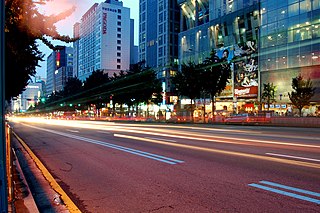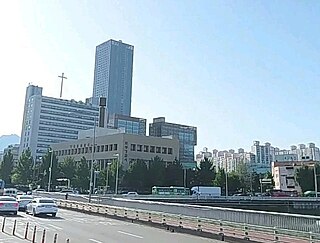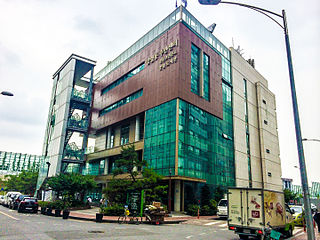
Yeongdeungpo District is an administrative district in southwest Seoul, South Korea. Although the origin of the name is uncertain, the first two syllables are thought to be from "yeongdeung" (靈登) or "divine ascent", a shamanic rite. The third syllable is "po", representing the bank of a river (浦), referring to the district's position on the Han River. The 2006 population was 408,819.

Seodaemun District is one of the 25 districts of Seoul, South Korea.

Gangbuk District (Gangbuk-gu) is one of the 25 gu which make up the city of Seoul, South Korea. Its name is derived from it being located at the north of Han river. It was created from neighbouring Dobong District (도봉구) in 1995. The current mayor is Park Gyeom-su.

Seongdong District (Seongdong-gu) is one of the 25 gu which make up the city of Seoul, South Korea. It is situated on the north bank of the Han River. It is divided into 20 dong (neighbourhoods).

Dobong District is one of the 25 districts of Seoul, South Korea. As of 2020, Dobong has a population of 315,979 and an area of 20.71 square kilometres (8.00 sq mi), and is divided into four administrative neighborhoods. The district is located in northeastern Seoul, bordering the Gyeonggi Province cities of Yangju and Uijeongbu to the north, and the districts of Gangbuk to the southwest and Nowon to the east.

Gwangjin District is one of the 25 districts of Seoul, South Korea. It is located on the north bank of the Han River on the eastern end of Seoul. The district was split from the neighboring Seongdong District in 1995.

Jungnang District (Jungnang-gu) is one of the 25 gu, or districts, of Seoul, South Korea. It is located on the north side of the Han River.

Gil-dong Station is a subway station on Seoul Subway Line 5 in Gangdong-gu, Seoul. There is a connecting track from this station to Dunchon-dong Station on the Macheonji Line of Line 5, but it is a return train track for the arrival and departure of the Godeok Vehicle Business Office and has nothing to do with passenger operations.

Sangil-dong station is the subway station of Line 5 in Gangdong-gu, Seoul. Seoul Metro have extended the subway line from this station to Hanam Geomdansan in the nearby city of Hanam.

Bangi-dong is a neighbourhood, dong of Songpa-gu, Seoul, South Korea.

Pungnap-dong is a neighbourhood, dong of Songpa-gu, Seoul, South Korea.

Amsa-dong is a dong (neighbourhood) of Gangdong-gu in Seoul, South Korea. The dong is well known for the Amsa-dong Prehistoric Settlement Site, in which Neolithic remains were excavated after a large amount of diagonal-line patterned earthenware(Korean:빗살무늬토기) was exposed by a flood in 1925. It is thought to be a Jomonic settlement which existed prior to the spread of Songgukri-cultural sphere in Korean peninsula during the Korean bronze age. In Amsa Sam-dong, a festival named Amsa sunsa cultural festival is hold annually and parade is performed. It has a subway station of Seoul metropolitan subway 8th line, which functions as the last station of the line. There is only one high school in Amsa-dong named Sunsa highschool. The neighborhood is also known for its large traditional market. Amsa dong is divided in three, Amsa il-dong, Amsa I-dong, Amsa Sam-dong, and community centre is present in every one of these divisions. It is currently part of Gangdong-Gu of Seoul metropolitan city adminstration.

Cheonho-dong (Korean: 천호동) is a dong, neighbourhood of Gangdong-gu in Seoul, South Korea.

Gangil-dong is a dong, neighbourhood of Gangdong-gu in Seoul, South Korea.

Godeok-dong is a dong, neighbourhood of Gangdong-gu in Seoul, South Korea.

Gil-dong is a dong, neighbourhood of Gangdong District in Seoul, South Korea.
Myeongil-dong is a dong, neighbourhood of Gangdong-gu in Seoul, South Korea.
Sangil-dong is a dong, neighbourhood of Gangdong-gu in Seoul, South Korea.

Gangdong Station is a station on Seoul Subway Line 5. The line branches off to the northeast and the southeast at this point, with Gil-dong station to the northeast and Dunchon-dong station to the southeast. Cheonho station precedes it on the west.

Gubeundari Station is a subway station on Seoul Subway Line 5 in Gangdong-gu, Seoul.






















